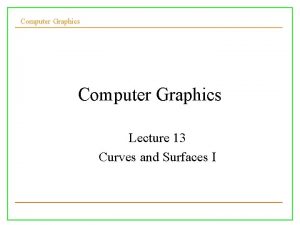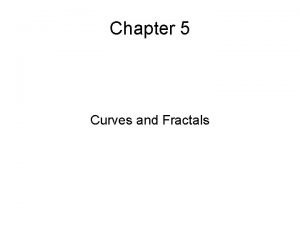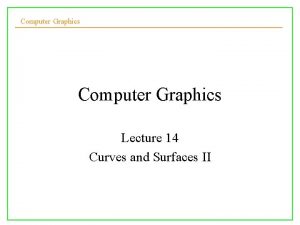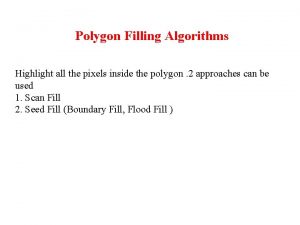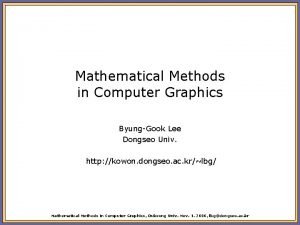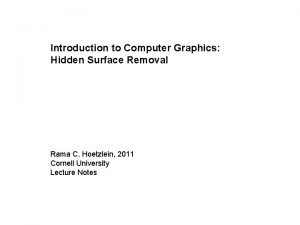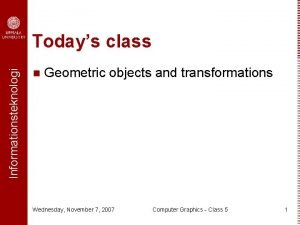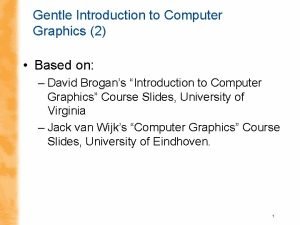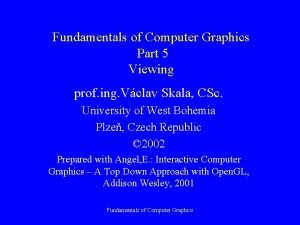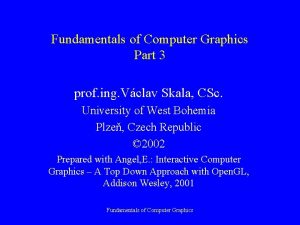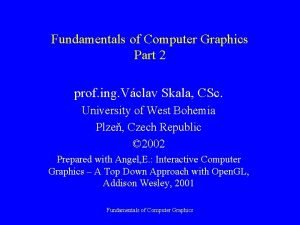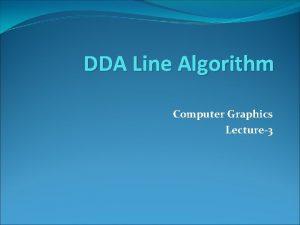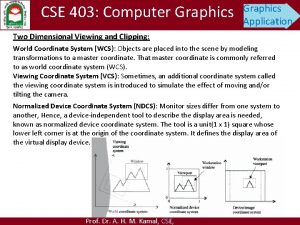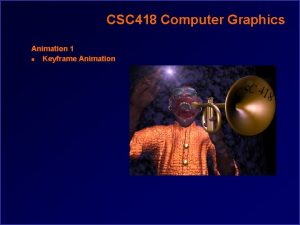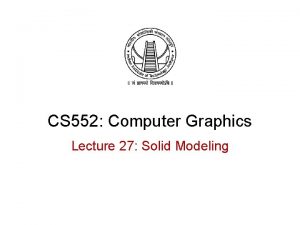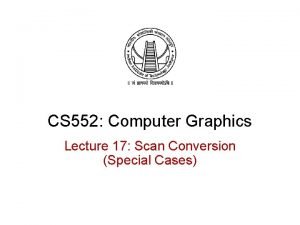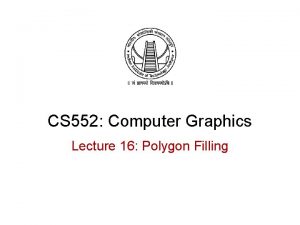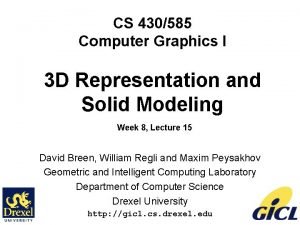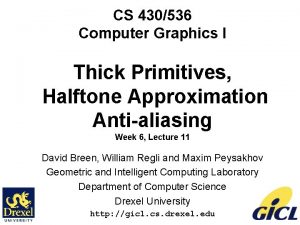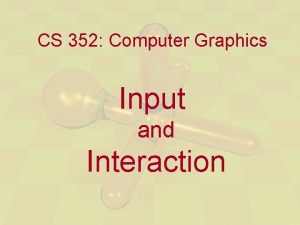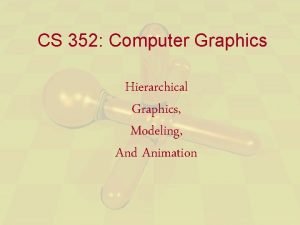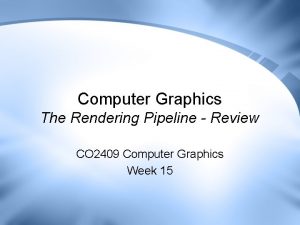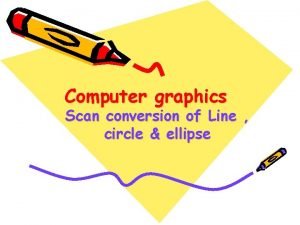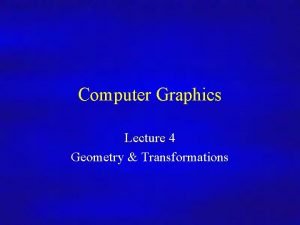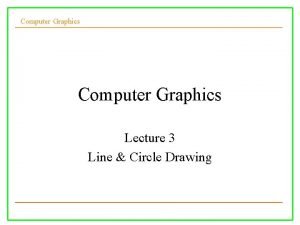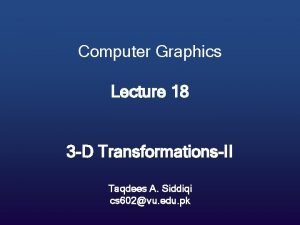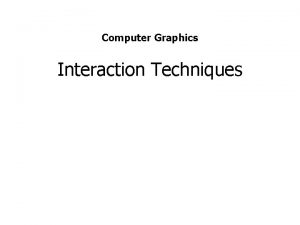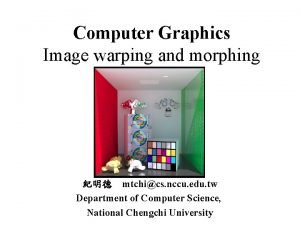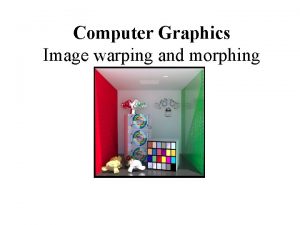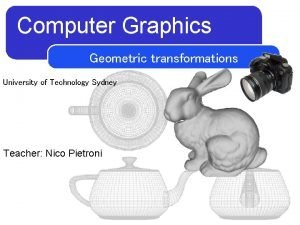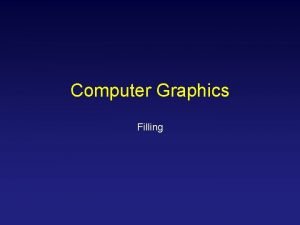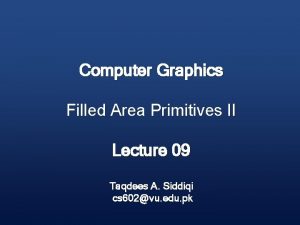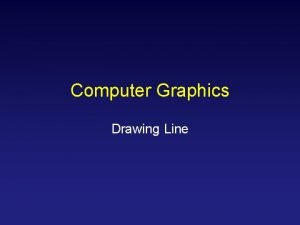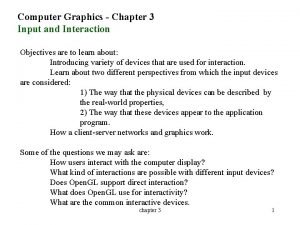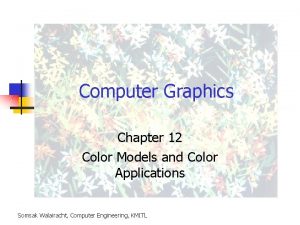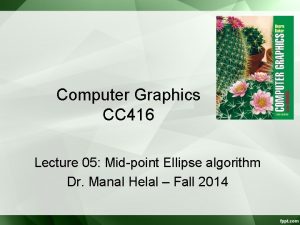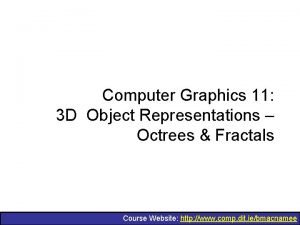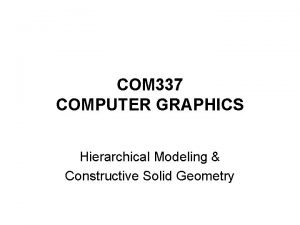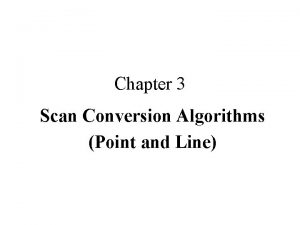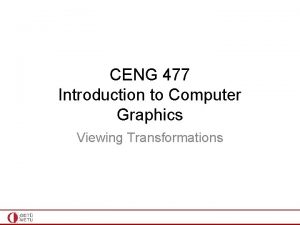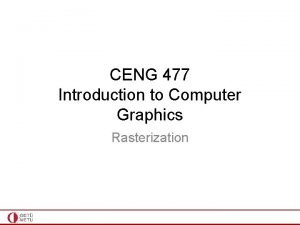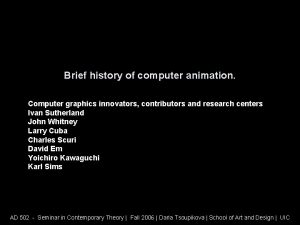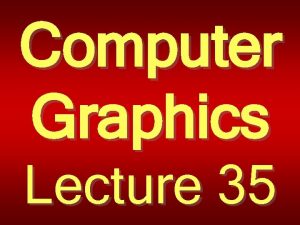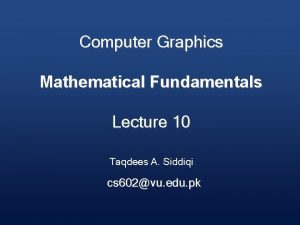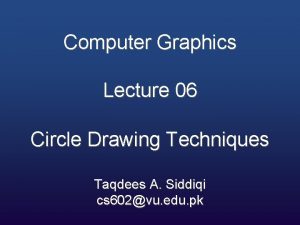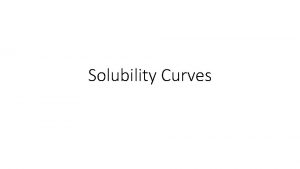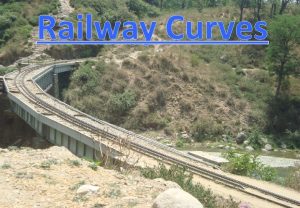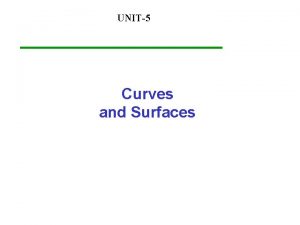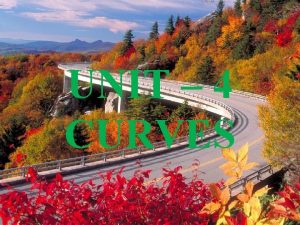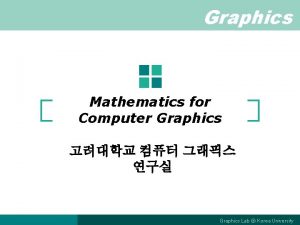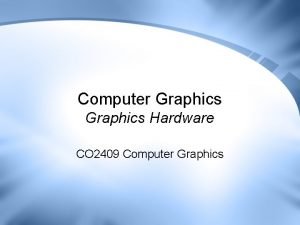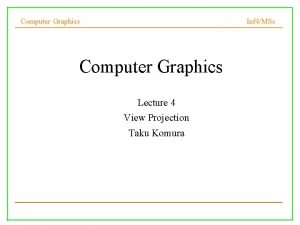Computer Graphics Lecture 37 CURVES III Taqdees A







































































- Slides: 71

Computer Graphics Lecture 37

CURVES III Taqdees A. Siddiqi cs 602@vu. edu. pk

The Tangent Vector

• Another way to define a space curve does not use intermediate points. It uses the tangents at each end of a curve, instead

• Every point on a curve has a straight line associated with it called the tangent line, which is related to the first derivation of the Parametric functions x(u), y(u), and z(u)

Equation (1)

• From elementary calculus, we can compute, for example,

Equation (2)

• We can treat as components of a vector along the tangent line to the curve. We call this the tangent vector, and define it as

Equation (3)

• Or more simply as Equation (4)

• (Here the superscript u indicates the first derivative operation with respect to the independent variable u). This is a very powerful idea, and we will now see how to use it to define a curve

• We will still use the two end points, but instead of two intermediate points, we will use the tangent vectors at each end to supply the information we need to define a curve

• By manipulating these tangent vectors, we can control the slope at each end. The set of vectors , , , and are called the boundary conditions

• This method itself is called the cubic Hermite interpolation, after C. Hermite (1822 -1901) the French mathematician who made significant contributions to our understanding of cubic and quadratic polynomials.

• We differentiate to obtain the x component of the tangent vector:

Equation (5)

Pu 1 Pu 0 P 0 Figure (1)

Equation (1 A)

• Evaluating (1 A) and Equation 5 at u = 0, u = 1, yields

Equation (6)

• Using these four equations in four unknowns, we solve for ax , bx , cx and dx in terms of the boundary conditions

Equation (7)

• Substituting the result into Equation (1 A), yields Equation (8)

• Rearranging terms we can rewrite this as Equation (9)

• Because y(u) and z(u) have equivalent forms, we can include them by rewriting Equation 9 in vector form:

Equation (10)

• To express Equation 14. 54 in matrix notation, we first define a blending function matrix Where

Equation (11)

• These matrix elements are the polynomial coefficients of the vectors which we rewrite as:

Equation (12)

• If we assemble the vectors representing the boundary conditions into a matrix B,

Equation (13)

Then Equation (14)

• Here again we write the matrix F as the product of two matrices, U and M, so that

Equation (15)

• where Equation (16)

• And Equation (17)

• Rewriting Equation 14 using these substitutions, we obtain Equation (18)

• It is easy to show the relationship between the algebraic and geometric coefficients for a space curve. Since

Equation (19)

• the relationship between A and B is, again, Equation (20)

• The magnitude of the tangent vector is also necessary and contributes to the shape of the curve. In fact, we can write and as

Equation (21)

And Equation (22)

• Clearly, m 0, and m 1 are the magnitudes of and. • Using these relationships, we modify Equation 10 as follows:

Equation (23)

Computer Graphics Lecture 37

• To define a space curve we must use parametric functions that are cubic polynomials. For x(u) we write: Equation (1)

• A space curve is not confined to a plane. It is free to twist through space.

Space Curves

• we combine the x(u), y(u) and z(u) expressions into a single vector equation : Equation (2)

• If a = 0, then his equation is identical to Equation discussed in plane curves

• So we now have the four points we need. P 1/3 z P 0 y x P 2/3

• So we now have the four points we need. P 1/3 z P 0 y x P 2/3

Equation (3)

Equation (4)

Equation (5)

• Rewriting Equation 5 as follows: Equation (6)

Equation (7)

• This means that, given four point assigned successive values of u (in this case at u=0, 1/3, 2/3 & 1), equation 7 produces a curve that starts at p 1, passes through p 2 and p 3, and ends at p 4.

• Now let’s take one more step towards a more compact notation. Using the four parametric functions appearing in Equation 7, we define a new matrix, where

Equation (8)

• And then define a matrix P containing the control points, • so that Equation (9)

• The matrix G is the product of two other matrices, U and N: Equation (10)

• Where • And Equation (11)

Equation (12)

• Using matrices, Equation 2 becomes Equation (13)

• And then Equation (14) • And then Equation (15)

• Or more simply Equation (16)

• which we can rewrite as the more convenient p 1, p 2, p 3, and p 4 (Figure 1).
 Hermite curve in computer graphics
Hermite curve in computer graphics What are curves in computer graphics
What are curves in computer graphics Computer graphics
Computer graphics Graphics monitors and workstations
Graphics monitors and workstations Lcd working principle ppt
Lcd working principle ppt Hamlet act iii scene iii
Hamlet act iii scene iii 01:640:244 lecture notes - lecture 15: plat, idah, farad
01:640:244 lecture notes - lecture 15: plat, idah, farad Computer security 161 cryptocurrency lecture
Computer security 161 cryptocurrency lecture Computer-aided drug design lecture notes
Computer-aided drug design lecture notes Computer architecture lecture notes
Computer architecture lecture notes Microarchitecture vs isa
Microarchitecture vs isa Crt in computer graphics
Crt in computer graphics Projection in computer graphics
Projection in computer graphics What is plasma panel display in computer graphics
What is plasma panel display in computer graphics Exterior clipping
Exterior clipping Shear transformation in computer graphics
Shear transformation in computer graphics Shader computer graphics
Shader computer graphics Scan conversation
Scan conversation Center of mass of a rigid body
Center of mass of a rigid body Boundary fill algorithm in computer graphics
Boundary fill algorithm in computer graphics Advantages and disadvantages of scan line fill algorithm
Advantages and disadvantages of scan line fill algorithm Polygon filling algorithms
Polygon filling algorithms Random scan display
Random scan display Computer graphics
Computer graphics What is line drawing algorithm
What is line drawing algorithm Cs 418 interactive computer graphics
Cs 418 interactive computer graphics Cs 418 interactive computer graphics
Cs 418 interactive computer graphics Depth sorting method in computer graphics
Depth sorting method in computer graphics Achromatic light in computer graphics
Achromatic light in computer graphics What is interactive input
What is interactive input Uniform scaling in computer graphics
Uniform scaling in computer graphics Uniform scaling in computer graphics
Uniform scaling in computer graphics Orthogonal projection in computer graphics
Orthogonal projection in computer graphics Logical input devices in computer graphics
Logical input devices in computer graphics Sierpinski gasket in computer graphics
Sierpinski gasket in computer graphics Polygon clipping in computer graphics ppt
Polygon clipping in computer graphics ppt Introduction to computer graphics ppt
Introduction to computer graphics ppt Differential line algorithm in computer graphics
Differential line algorithm in computer graphics Normalized device coordinate
Normalized device coordinate Keyframe system in computer graphics
Keyframe system in computer graphics Sweep representation in computer graphics
Sweep representation in computer graphics Scan conversion in computer graphics
Scan conversion in computer graphics Flood fill algorithm in computer graphics
Flood fill algorithm in computer graphics Utah teapot vertex data
Utah teapot vertex data Thick primitives in computer graphics
Thick primitives in computer graphics Interaction in computer graphics
Interaction in computer graphics Computer graphics
Computer graphics Rendering pipeline in computer graphics
Rendering pipeline in computer graphics What is the basis of scan conversion of a circle
What is the basis of scan conversion of a circle Srgp in computer graphics
Srgp in computer graphics Transformation computer graphics
Transformation computer graphics Gupta sproull algorithm
Gupta sproull algorithm Uniform scaling in computer graphics
Uniform scaling in computer graphics Input of graphical data in computer graphics
Input of graphical data in computer graphics Sutherland hodgman algorithm in computer graphics
Sutherland hodgman algorithm in computer graphics Amber
Amber Wrapping in computer graphics
Wrapping in computer graphics Frame yv
Frame yv What is polygon filling
What is polygon filling Filled area primitives
Filled area primitives How to draw line in computer graphics
How to draw line in computer graphics Curve attributes in computer graphics
Curve attributes in computer graphics Objectives of computer graphics
Objectives of computer graphics Cmy and hsv color model
Cmy and hsv color model What is pixmap in computer graphics
What is pixmap in computer graphics Midpoint ellipse algorithm derivation
Midpoint ellipse algorithm derivation Octrees in computer graphics
Octrees in computer graphics Hierarchical modeling in computer graphics
Hierarchical modeling in computer graphics Scan conversion algorithms
Scan conversion algorithms Cvv in computer graphics
Cvv in computer graphics Triangle rasterization algorithm
Triangle rasterization algorithm History of computer graphics
History of computer graphics
